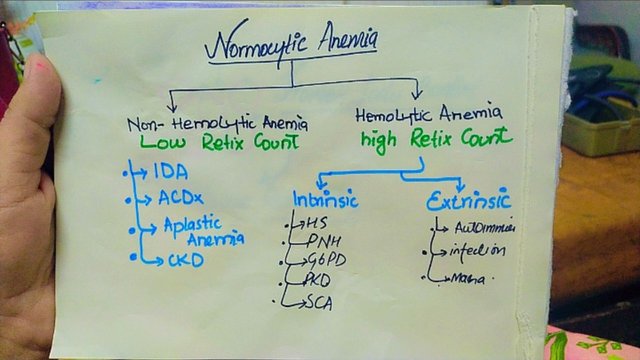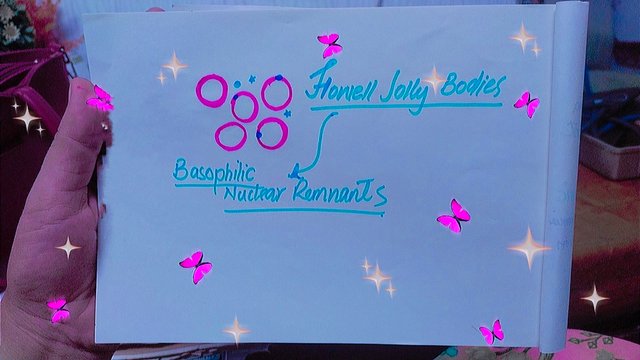SEC S20W5 || Hemolytic Anemias - Module 5
I am thankful to @dexsyluz for organizing inspiring and informative Contest for us.This this is very valuable and after long time I was being through this knowledge so it is really informative for me and I think all of us who are taking part in this competition.

Hemolytic Anemia
I would describe the term hemolytic Anemia
Lysis means breakdown of anything and hemo mean blood mainly the red blood cells it means that the breakdown of the red blood cell is called hemolytic which leads to deficiency of red blood cells and the term as hemolytic anaemia.
As in our last class we learn in detail about IPR and even we can implement in our today's topic as well you know it's active breakdown of red blood cells is going on in our body we are not talking about the cause which lead to decrease our RBCs production in our body in order to compensate this deficiency the fresh RBCs which are immature cell called as reticulocyte well increase in our blood circulation.
And we already talk about in detail in our last class when there is regenerative anaemia in which there is a huge amount of reticulocyte more than 3 percent of IPR index.
Classification of Hemolytic Anemia
- Intravascular
Means The breakdown of red blood cells is occurring inside of the blood vessels. - Extravascular Hemolysis
The RBC breakdown occur outside of the blood vessel it can be in the spleen and liver mainly in our body.
So before we tell you in detail about hemolytic Anemia type in the last lectures when we talk about the anaemia we divided it into the - microcytic
- macrocytic
- normocytic
Hemolytic anaemia comes under the normocytic type.Normocytic Anemia can be of two type - Hemolytic
- Non hemolytic
Non hemolytic
According to reticulocyte count index
- Iron Deficiency
- ACDz
- Aplastic Anaemia
- CKD
Hemolytic
Which I already mentioned with high reticulocyte count percentage Can be further of two types
- Intrinsic
- Extrinsic
Extrinsic
There are very common causes some of them for example infection
- Macroangiopathic
- Microangiopathic
- Autoimmunity
Intrinsic
Enzyme Defect/Deficiency
- Pyruvate kinase deficiency
- G6PD deficiency
Membrane Damage - HS
- PNH
Hemoglobin Synthesis Defect - HbC
- Sickle cell anemia

Define Sickle Cell Anemia
Sickle cell anaemia is an hereditary disorder which is due to defect in the hemoglobin synthesis when there is a defect in the hemoglobin which is inside of the red blood cells so the result is red blood cells become more hard and easy to deshape and breakdown.
Pathogenesis
If I talk about the cause why this happens actually we have alpha and beta chains in hemoglobin so there is only one single amino acid which is mutated in this example glutamic acid is replaced by valine.
So this mutation work called this hemoglobin from hbA to HbS. And it is leading to two types of hemolysis whether intravascular as well as extravascular hemolysis is going on in the patient of sickle cell anemia.
So this abnormal hemoglobin Atlee it is made under the condition in which there is Oxygen low so what happened is that red blood cells will shape into sickle cells and easy to break down inside the blood vessel.
Sign and Symptoms
Patient present to us is very pale looking and easy to get tired most importantly the jaundice yellow colors are sclera. On examination the most important finding is splenomegaly or hepatomegaly.
Types According to Severity
- The most dangerous type is HbSS
- Moderate one is HbSc
- Varies

Diagnostic Test
We need to get the patient complete blood cell count and in order to make the diagnosis we must get genetic testing to confirm diagnosis.
Rx
As we mentioned and that there is hemolysis going on in the body blood transfusion sometime on weekly basis and as bone marrow is order to compensating and try to do more work so there is bonne pain as well we need to manage that came and another thing is sometime we also need stem cell transplant.Along with that most important thing is not to forget his folic acid supplementation so that the red blood cell count can be increased.
Intravascular Vs Extravascular Hemolysis
As I already mention normocytic anaemia is divided into hemolytic and non hemolytic and then I have divided the hemolytic anaemia into intrinsic and extrinsic according to cause of hemolysis and if we see the location of hemolysis then it is divided into intravascular and extravascular
There are some diagnostic features for example during hemolysis levels there is an increased level of LDH, unconjugated bilirubin, reticulocyte count, urobilinogen in the urine.
| Intravascular hemolysis | Extravascular |
|---|---|
| Dec haptoglobin, Hemosiderinuria, Hemoglobinnuria, PN hemoglobinuria, MAHA | Macrophages in spleen, Spherocytes in PS,But differentiated from intravascular there is no hemoglobinuria and hemosiderinuria |
| Intravascular Hemolysis means breakdown occurs inside of blood vessels when it breakdown it can be eliminated through the body via urine and it is termed as hemoglobinuria means hemoglobin in the urine but not red and in the normal human being there are no hemoglobinuria or red cells in the urine. | Means the red blood cells breakdown outside of the blood vessels but mainly lymphoid organs liver and spleen. |
| Cause Acute cause may be due to malaria Autoimmune hemolytic Anemia, Snake venom, Blood reaction. It is more dangerous because occuring inside of blood vessels | Splenomegaly because the destruction occurs in lymphoid organs. Causes ,Hereditary spherocytosis, Hepatitis |
Elimination Routes for Intravascular Hemolysis
There is another way to eliminate from the body that is one carrier protein which is called haptoglobin produced by the liver and then it binds with hemoglobin and catabolizes in the liver and there are many step processes and forms indirect bilirubin. The third way of elimination is through kidneys but it is very dangerous by product which is very nephrogenic called hemosiderin.
Explain a case of Hemolytic Anemia
I wanted to discuss a case of hemolytic Anemia there was a very young girl of around 22 years old and she presented to me with the complaint of being tired so much along with that her colour of sclera wall yellow and along with that she complaint that her colour of urine is very darker.
When I asked her if she was using any medication or any other disease she suffering a from she said entirely no. Then I ask her that I will do some examination to make sure what she is suffering from.
On examination I fond her heart rate was around 130/ min and when I palpate her spleen it was significant enlarged. Along with that some of her lymph node also big.
I sent some of her lab investigations I wanted to make the diagnosis.
| Lab investigations | Results |
|---|---|
| Hemoglobin | 5.3 g/dL |
| HCT | 15% |
| Peripheral smear | broken RBC with round/spherocytes |
| Coombs test Direct | positive |
Dx
This is called an example of intravascular Hemolysis known as autoimmune hemolytic Anemia
Rx
I prescribe her folic acid IV immunoglobulin and with that some of the steroids to reduce our body to react against our own body and of course blood transfusion to improve Anemia.
Upvoted. Thank You for sending some of your rewards to @null. It will make Steem stronger.
Thank you for the support
Your post on health topic can save life for many. Posts like this are much needed to raise awareness about hemolytic anemias. Good luck for the contest.